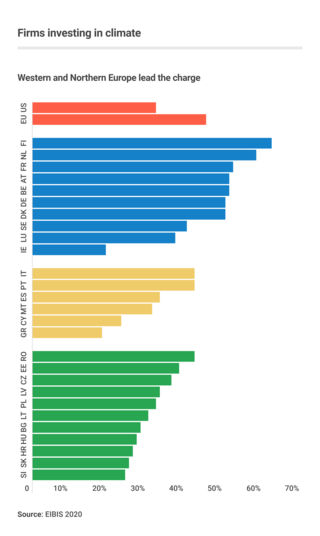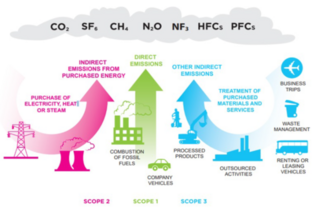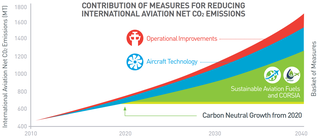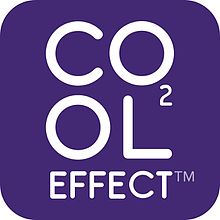The Chicago Climate Exchange(CCX) was a voluntary, legally binding greenhouse gas reduction and trading system for emission sources and offset projects in North America and Brazil.
The Clean Development Mechanism (CDM) is a United Nations-run carbon offset scheme allowing countries to fund greenhouse gas emissions-reducing projects in other countries and claim the saved emissions as part of their own efforts to meet international emissions targets. It is one of the three Flexible Mechanisms defined in the Kyoto Protocol. The CDM, defined in Article 12 of the Protocol, was intended to meet two objectives: (1) to assist non-Annex I countries achieve sustainable development and reduce their carbon footprints; and (2) to assist Annex I countries in achieving compliance with their emissions reduction commitments.

Carbon offsetting is a trading mechanism that allows entities such as governments, individuals, or businesses to compensate for (i.e. “offset”) their greenhouse gas emissions by supporting projects that reduce, avoid, and/or remove emissions elsewhere. A carbon credit or offset credit is a transferrable financial instrument, that is a derivative of an underlying commodity. It can be bought or sold after certification by a government or independent certification body. When an entity invests in a carbon offsetting program, it receives carbon credits, i.e the "tokens" used to account for net climate benefits from one entity to another. One carbon offset or credit represents a reduction, avoidance or removal of one tonne of carbon dioxide or its carbon dioxide-equivalent (CO2e). Offset projects that take place in the future can be considered to be a type of promissory note: The purchaser of the offset credit pays carbon market rates for the credits and in turn receives a promise that the purchaser's greenhouse emissions generated in the present (e.g. a roundtrip flight to London) will be offset by elimination of an equal amount in the near or distant future (e.g. 10-20 years for planting 110 seedlings). Offsets that were generated in the past are credible only if they were in addition to reductions that would have happened anyway.

Business action on climate change includes a range of activities relating to climate change, and to influencing political decisions on climate change-related regulation, such as the Kyoto Protocol. Major multinationals have played and to some extent continue to play a significant role in the politics of climate change, especially in the United States, through lobbying of government and funding of climate change deniers. Business also plays a key role in the mitigation of climate change, through decisions to invest in researching and implementing new energy technologies and energy efficiency measures.

The Carbonfund.org Foundation is a 501(c)(3) not-for-profit organization based in East Aurora, New York, that provides carbon offsetting and greenhouse gas reduction options to individuals, businesses, and organizations. Carbonfund.org Foundation purchases and retires certified carbon offsets on behalf of its donors. Donors are given a choice of project type to which they may donate, including renewable energy, reforestation, and energy efficiency projects. Carbonfund.org Foundation sources carbon credits verified by the Verra carbon standard and Gold Standard. The organization has helped develop four Reducing Emissions from Deforestation and Degradation (REDD+) projects in Brazil under the VERRA and Climate, Community and Biodiversity standards.

Carbon accounting is a framework of methods to measure and track how much greenhouse gas (GHG) an organization emits. It can also be used to track projects or actions to reduce emissions in sectors such as forestry or renewable energy. Corporations, cities and other groups use these techniques to help limit climate change. Organizations will often set an emissions baseline, create targets for reducing emissions, and track progress towards them. The accounting methods enable them to do this in a more consistent and transparent manner.

Aircraft engines produce gases, noise, and particulates from fossil fuel combustion, raising environmental concerns over their global effects and their effects on local air quality. Jet airliners contribute to climate change by emitting carbon dioxide, the best understood greenhouse gas, and, with less scientific understanding, nitrogen oxides, contrails and particulates. Their radiative forcing is estimated at 1.3–1.4 that of CO2 alone, excluding induced cirrus cloud with a very low level of scientific understanding. In 2018, global commercial operations generated 2.4% of all CO2 emissions.
TerraPass is a social enterprise that provides carbon offsetting products. TerraPass use proceeds from member purchases to fund greenhouse gas reduction projects.
The Gold Standard (GS), or Gold Standard for the Global Goals, is a standard and logo certification mark program, for non-governmental emission reductions projects in the Clean Development Mechanism (CDM), the Voluntary Carbon Market and other climate and development interventions. It is published and administered by the Gold Standard Foundation, a non-profit foundation headquartered in Geneva, Switzerland. It was designed with an intent to ensure that carbon credits are real, verifiable, and that projects make measurable contributions to sustainable development. The objective of the GS is to add branding, with a quality label, to carbon credits generated by projects which can then be bought and traded by countries that have a binding legal commitment according to the Kyoto Protocol, businesses, or other organizations for carbon offsetting purposes.

Carbon pricing is a method for nations to address climate change. The cost is applied to greenhouse gas emissions in order to encourage polluters to reduce the combustion of coal, oil and gas – the main driver of climate change. The method is widely agreed and considered to be efficient. Carbon pricing seeks to address the economic problem that emissions of CO2 and other greenhouse gases (GHG) are a negative externality – a detrimental product that is not charged for by any market.

ClimateCare is a profit for purpose environmental and social impact company known for its role providing carbon offset services, with a particular focus on using carbon and other results based finance to support its 'Climate+Care Projects'. It also provides businesses and governments with sustainable development programmes, environmental and social impact measurement and project development.

Carbon emission trading (also called emission trading scheme (ETS) or cap and trade) is a type of emission trading scheme designed for carbon dioxide (CO2) and other greenhouse gases (GHG). It is a form of carbon pricing. Its purpose is to limit climate change by creating a market with limited allowances for emissions. This can lower competitiveness of fossil fuels and accelerate investments into low carbon sources of energy such as wind power and photovoltaics. Fossil fuels are the main driver for climate change. They account for 89% of all CO2 emissions and 68% of all GHG emissions.
Personal carbon credits are carbon credits created and owned by individuals who reduce their green house gas (GHG) emissions by a real and verifiable amount. Individuals cause GHG emissions from a variety of direct and indirect activities including transportation use, electrical use and home heating and cooling. Verifiable reductions in GHG emissions are aggregated into 1 metric ton increments and they become personal Carbon Credits. There are many firms that are creating applications to efficiently measure and track these emissions, while providing options to purchase and offset personal emissions.
Although it is a worldwide treaty, the Kyoto Protocol has received criticism.

Individual action on climate change can include personal choices in many areas, such as diet, travel, household energy use, consumption of goods and services, and family size. Individuals can also engage in local and political advocacy around issues of climate change. People who wish to reduce their carbon footprint, can take "high-impact" actions, such as avoiding frequent flying and petrol fuelled cars, eating mainly a plant-based diet, having fewer children, using clothes and electrical products for longer, and electrifying homes. Avoiding meat and dairy foods has been called "the single biggest way" an individual can reduce their environmental impact. Excessive consumption is more to blame for climate change than population increase. High consumption lifestyles have a greater environmental impact, with the richest 10% of people emitting about half the total lifestyle emissions.
Pedro Moura Costa is an entrepreneur involved in environmental finance with a focus on the international efforts for greenhouse gas (GHG) emission reductions. Of particular relevance, he was the founder and President of EcoSecurities Group Plc., one of the leading project developers for the international carbon markets, and has written widely about the policy and science of climate change mitigation, including contributions to the Intergovernmental Panel on Climate Change (IPCC) reports.
The Verified Carbon Standard (VCS), formerly the Voluntary Carbon Standard, is a standard for certifying carbon credits to offset emissions. VCS is administered by Verra, a 501(c)(3) organization.

Deforestation is a primary contributor to climate change, and climate change affects forests. Land use changes, especially in the form of deforestation, are the second largest anthropogenic source of atmospheric carbon dioxide emissions, after fossil fuel combustion. Greenhouse gases are emitted during combustion of forest biomass and decomposition of remaining plant material and soil carbon. Global models and national greenhouse gas inventories give similar results for deforestation emissions. As of 2019, deforestation is responsible for about 11% of global greenhouse gas emissions. Carbon emissions from tropical deforestation are accelerating. Growing forests are a carbon sink with additional potential to mitigate the effects of climate change. Some of the effects of climate change, such as more wildfires, insect outbreaks, invasive species, and storms are factors that increase deforestation.

The Carbon Offsetting and Reduction Scheme for International Aviation (CORSIA) is a carbon offset and carbon reduction scheme to lower CO2 emissions for international flights, to curb the aviation impact on climate change.
Nori Inc. is a technology startup based in Seattle, Washington. The company is building financial infrastructures to allow carbon removal projects to measure and get economic revenues from their activity. By doing so, Nori aims to establish a universal market-driven commodity price on carbon removal. Nori is focused on soil-carbon sequestration and pays farmers who adopt regenerative agriculture practices which may contribute to carbon sequestration.











